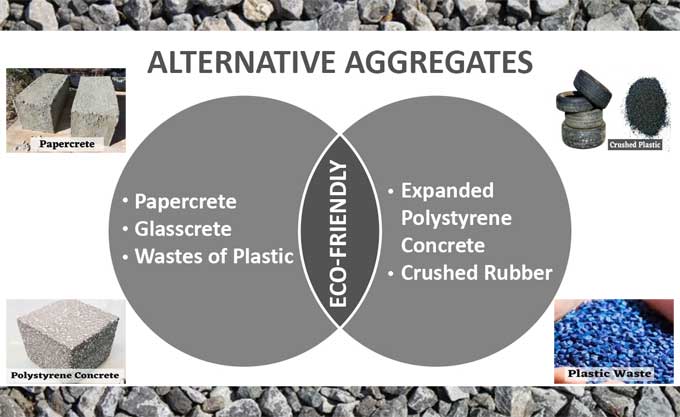
Know about alternative options to concrete & aggregates

The concrete business is actually very large, with a value of several billion dollars. Concrete makes up the majority of the structures you can see. Concrete, the most often used building material worldwide, serves as the basis for all types of infrastructure.
Due to its flexible and vigorous utilization, its annual manufacturing rate is over a few billion tonnes. Besides forming the very foundation of our infrastructure, concrete is also one of the most widely used construction materials in the world.
Cement, fine aggregates, coarse aggregates, and water are the main ingredients of concrete. You will learn about a few reasonably priced and environmentally friendly concrete aggregate alternatives in the sections that follow. Concrete is more environmentally responsible and sustainable thanks to these substitute aggregates.
A green revolution, or the adoption and introduction of environmentally friendly materials, is urgently needed in construction and other industries in light of the present climatic situation and the phenomenon of global warming.
Few Alternatives for Concrete
Green Concrete Alternative
Using leftovers or waste products from a variety of sectors to produce green concrete can be considered an eco-friendly way to produce concrete that uses less energy during the production process. It is not only cheaper and stronger than conventional concrete but also emits less carbon dioxide than it.
Green concrete is used to reduce the demand for natural resources and enhance reliance on recyclables. Reusing wash water to cut down on water usage is one of the many methods being used to attain sustainability through eco-friendly concrete.
One of the finest methods for producing environmentally friendly construction materials is to partially replace energy-intensive cement with reusable components.
Ashcreate Alternative
Ashcrete is a recycled fly ash-based alternative to conventional concrete. To make fly ash strong and lasting, similar to normal cement, lime and water are added. Fly ash is an environmentally favorable substitute for cement since it may be used in its place, which reduces carbon dioxide emissions.
High-volume fly ash concrete may also replace 25% of the cement. Other advantages of fly ash over conventional concrete include decreased bleeding, higher concrete strength, and decreased shrinkage.
Fly ash not only prevents the concrete from reacting with alkali and silicon, but it also makes the concrete resistant to its reactivity with alkali and silicon.
Blast Furnace Alternative Option
The blast furnace slag, just like the fly ash produced in the furnaces, is one of the byproducts of a furnace that can be recycled and utilized in an eco-friendly manner to make an alternative to concrete.
When molten iron slag is quenched in water or steam, a glassy granular material will be formed which can then be used as a filler material.
In this process, blast furnace slag emits less heat for hydration, which makes it more environmentally friendly.
Silica Alternative Options
Micro Silica is an ultrafine powder that is created as a by-product of the condensation of silicon dioxide during the manufacturing of ferrosilicon alloy and silicon. Concrete is known to last longer thanks to micro silica's capacity to increase compressive strength while reducing permeability.
Specifically, silica fume concrete is used for construction structures that are exposed to harsh chemicals, such as chemical storage tanks. Eco-friendly concrete is much more environmentally friendly than traditional concrete.
Few alternatives for Aggregates
To reduce greenhouse gas emissions associated with traditional concrete construction, a great deal of effort is being put into finding safer substitutes for cement as well as replacing aggregate materials with recyclable and reusable materials.
Papercrete Aggregates Alternative
Paper waste that is recycled and utilized as an aggregate material in the production of concrete is used to create papercrete. Even if papercrete only partially replaces cement in the mixture, it can still mitigate some of the negative impacts of concrete manufacture.
Concrete Debris Alternative
The utilization of concrete debris is a creative approach to recycling leftover concrete and reducing the number of resources needed to produce a design. By reusing the garbage, this procedure conserves important landfill space and uses less virgin raw materials.
To learn more, watch the following video tutorial.
Video Source: Amazing Engineering | ACES
Waste Plastics can be an Option
Given that waste plastic is a non-biodegradable substance, using it is a wise choice. Plastic trash may readily replace up to 20% of conventional aggregate materials since it can be recycled so simply.
Despite the fact that concrete that is produced using plastic waste can only provide strength within a specified range, it remains undoubtedly one of the most eco-friendly alternatives to traditional concrete.
Post-consumer Glass Alternatives
Since glass is an inert material, it is a good candidate to replace concrete as an aggregate material due to its versatility.
In addition to its durability, post-consumer glass increases the durability of concrete and provides a reduction in the amount of rubbish that is sent to landfills when it is recycled and repurposed in numerous ways without affecting its chemical properties.


